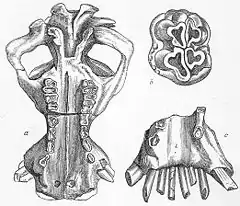| Hexaprotodon[1] | |||
| Falconer & Cautley, 1836[2] | |||
 Fragmenty czaszki Hexaprotodon sivalensis | |||
| Systematyka | |||
| Domena | |||
|---|---|---|---|
| Królestwo | |||
| Typ | |||
| Podtyp | |||
| Gromada | |||
| Podgromada | |||
| Infragromada | |||
| Rząd | |||
| Podrząd | |||
| Infrarząd | |||
| Rodzina | |||
| Rodzaj |
Hexaprotodon | ||
| Typ nomenklatoryczny | |||
|
Hippopotamus (Hexaprotodon) sivalensis Falconer & Cautley, 1836 | |||
| Synonimy | |||
|
| |||
| Gatunki | |||
| |||
Hexaprotodon – rodzaj wymarłego ssaka z rodziny hipopotamowatych (Hippopotamidae).
Charakterystyka
Przedstawiciele tego rodzaje zamieszkiwali Azję. Posiadali 3 pary siekaczy, od których pochodzi nazwa rodzajowa.
Systematyka
Etymologia
Podział systematyczny
Do rodzaju należały następujące gatunki[6]:
- Hexaprotodon bruneti Boisserie & T.D. White, 2004
- Hexaprotodon garyam Boisserie, Likius, Vignaud & Brunet, 2005
- Hexaprotodon hipponensis (Gaudry, 1876)
- Hexaprotodon imaguncula (Hopwood, 1926)
- Hexaprotodon pantanellii (Joleaud, 1920)
- Hexaprotodon sahabiensis Gaziry, 1987
- Hexaprotodon sivajavanicus Dubois, 1908
- Hexaprotodon sivalensis (Falconer & Cautley, 1836)
Uwagi
- ↑ Typ nomenklatoryczny: Hippopotamus (Hexaprotodon) sivalensis Falconer & Cautley, 1836; młodszy homonim Potamotherium É. Geoffroy Saint-Hilaire, 1833 (Mustelidae).
Przypisy
- ↑ Hexaprotodon, [w:] Integrated Taxonomic Information System (ang.).
- ↑ H. Falconer & P. Cautley. Note on the fossil Hippopotamus of the Sivalik Hills. „Asiatic researches, or, Transactions of the Society instituted in Bengal for inquiring into the history and antiquities, the arts, sciences and literature of Asia”. 19 (1), s. 51, 1836. (ang.).
- ↑ C.W.L. Gloger: Gemeinnütziges Hand- und Hilfsbuch der Naturgeschichte. Für gebildete Leser aller Stände, besonders für die reifere Jugend und ihre Lehrer. Breslau: A. Schulz, 1842, s. 127. (niem.).
- ↑ Palmer 1904 ↓, s. 324.
- ↑ Palmer 1904 ↓, s. 559.
- ↑ J.S. Zijlstra: Hexaprotodon. Hesperomys project. [dostęp 2022-07-27]. (ang.).
Bibliografia
- T.S. Palmer. Index Generum Mammalium: a List of the Genera and Families of Mammals. „North American Fauna”. 23, s. 1–984, 1904. (ang.).
This article is issued from Wikipedia. The text is licensed under Creative Commons - Attribution - Sharealike. Additional terms may apply for the media files.